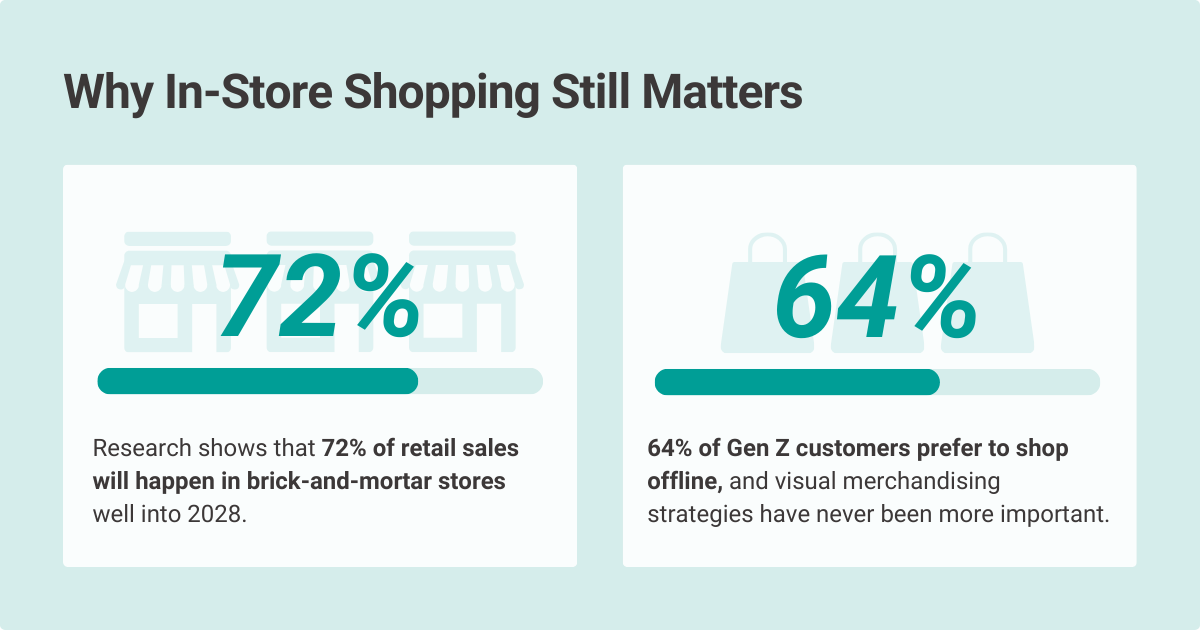The Psychology Behind the Sale: Our Visual Merchandising Strategies
In this article:
What makes consumers reach for their wallets? Is it a discount special, a new product release or an impulse purchase? Tapping into this consumer psychology and folding it into your visual merchandising strategies can mean the difference between getting noticed and being overlooked.
What Is Visual Merchandising and Why Does It Matter?
You’re surrounded by examples of visual merchandising every day. It’s the strategy of displaying products in a retail store in a manner that attracts customers and improves sales. This may involve creative displays, carefully planned product placement, and the psychology of color. Displays can enhance the shopping experience in “brick and mortar” stores.
Don’t discount the physical retail shopping experience, even in an era of e-commerce.

We Understand The Vital Role of Visual Merchandising Strategies
At McIntyre Displays, we understand the psychology of customer behavior, and we’re able to create and plan our displays accordingly. We’ll help ensure you get the attention your product needs. In addition, we’re also a Lowe’s and Home Depot approved supplier so you can trust us to get the job done right.
We ensure a seamless process, from design to creation to warehousing and distribution. By serving as a “one-stop shop,” we save you from the headache of working with multiple vendors. Are you ready to see how we can make your product stand out? Contact us today to get started.
One of the key insights into virtual merchandising strategies is the 5 R’s of merchandising.
What Are the 5 R’s of Retail Product Merchandising?
Consider the 5 R’s in your strategic method of grabbing customers’ attention, ensuring you have what they want or need, and focusing your efforts to net a sale.
The 5 R’s of retail product merchandising are:
- Right Merchandise: Before you can begin to think about a sale, you have to offer a product that spurs interest in your target audience. You need to be sure the right product is there to meet customer demands and take advantage of trends.
- Right Place: We briefly touched on this a bit earlier. The right place centers around ensuring that your product is strategically placed in the retail store to garner attention. For example, you may place high-demand items where they are easily accessible or at eye level. Optimal placement is crucial for your brand’s success.
- Right Time: Remember to plan ahead for seasonal items to be sure they are ready to roll when the time is right. Consider special events, trending merchandise, and peak demands.
- Right Quantity: How much should you stock? You want to find that balance of having plenty of product on hand but not so much that you’re faced with overstock. Be sure to have enough products to meet customer demand.
- Right Price: While price is important, it’s one of many factors consumers take into consideration when purchasing a product. However, you should price competitively and in a way that aligns with the perceived value of what you’re offering. Also, be sure to take the demographics of your customers into consideration—you don’t want to price too many of them out of the market.
These 5 R’s set the stage for success—but they need to be partnered with a powerful display. Next, we’ll briefly explore the impact of first impressions.
The Power of First Impressions: Let Visual Merchandising Give You an Edge
According to a study cited in the Cambridge University Press, people can make a decision in as little as a third of a second, particularly when searching for their favorite brands or foods.
Less than a second. That’s the amount of time you have to make a first impression. Shouldn’t you want to use every visual merchandising strategy at your disposal?
Let’s look at some of the key elements that guide those first impressions, particularly the role of lighting and the role of color.
The Role of Lighting in Visual Merchandising
Lighting plays a crucial role in visual merchandising by:
- Highlighting Your Product: Good lighting naturally creates a focal point. From there, you can direct the customer’s gaze toward your item. Strategic lighting also ensures that your product isn’t lost among the “noise” of the marketplace.
- Creating a Perfect Atmosphere: Do you sell spa products? Then maybe a low, “warm” light can evoke the relaxed feel of your item. Are you marketing something more dynamic? Use the energy from bright lights (just make sure they aren’t too bright or glaring).
- Enhancing Display and Product Colors: We’ll delve a little more into that in a moment, but remember that lighting and color go hand-in-hand. The right lighting can make textures and colors more appealing, which in turn can make an impact on that millisecond of a first impression.
At McIntyre Displays, we can easily integrate lighting into your display, whether that’s LED illumination or other sources of light. Just speak with our creative designers and let us capture your vision and make it a reality.
The Role of Color in Visual Merchandising
Color is one of the most powerful tools in visual merchandising because it affects mood, perception, and decision-making. We’ve broken down the psychology behind this powerful tool.
- Emotional Meaning: Be aware of the emotional impact of certain colors. For example, red often grabs attention, so it would be a good choice for sale items. Blue is often seen as a “calmer” color, one that promotes trust. In today’s global marketplace, it’s important to understand that certain colors may have powerful meanings in other countries. Be sure to consider cultural sensitivity when developing your color strategy.
- Brand Identity: The red in the Coca-Cola logo is a very distinct shade of red. It’s bold, grabs attention, and has become inseparable from the brand. The same can be said of the yellow of McDonald’s “golden arches.”
- At McIntyre Displays, we understand the importance of your brand. You’ve spent years–in many cases, even decades– building upon that loyalty. We can exactly match the shade of your logo so you can rest assured your brand’s integrity is always protected.
- Seasonal Themes: The Green of St. Patrick’s Day, the characteristic red and green of Christmas, and let’s not forget the dynamic red, white and blue that inundated stores around the Fourth of July. These made your product appear timely and relevant.
- Guide Your Customers’ Focus: Contrasting colors can guide the customer’s view toward the product. By combining that with yellow and orange, you have a combination that is great for drawing attention.
An important point to remember when working with color is that typically less is more. A display that has too many different colors may be seen as haphazard and confusing.
Harness the Power of Storytelling
Imagine that you’re selling grills. Now picture a display that features graphics of a family grilling burgers at a neighborhood gathering. This not only gets the customer’s attention, but it also tells a story. By opening this door, you invite the viewer to insert themselves into the narrative. You want them to envision themselves manning the grill and having a backyard party.
Now that the consumer is more “emotionally invested” in your product, they are more likely to engage with it…and ultimately purchase it!
McIntyre Displays: Complementing Your Merchandising Strategies With Stellar Displays
Let our captivating and engaging displays elevate your brand. Contact us today to get in touch with our innovative team to craft high-quality display solutions that are tailored to your needs. Because we do it all, you won’t have to worry about the multiple “points of failure” that can occur when working with different vendors.
See why we’ve been trusted by national brands for decades.
Key Takeaways:
- Visual merchandising is the strategic placement of your displays in stores to get customers’ attention.
- The 5 R’s of retail product merchandising are:
- Right merchandise
- Right place
- Right time
- Right quantity
- Right price
- Lighting, design and color are integral elements of a successful display.
- Creating displays that “tell a story” is more engaging to customers.
========
Sources:
Forbes, “Why Digital-Era Brands Are Opening Brick-And-Mortar Stores,” https://www.forbes.com/sites/kaleighmoore/2024/06/26/why-digital-era-brands-are-opening-brick-and-mortar-stores/
Interaction Design Foundation, “What Are Complementary Colors?” https://www.interaction-design.org/literature/topics/complementary-colorsopen link in new tab
Milosavljevic M, Koch C, Rangel A. Consumers can make decisions in as little as a third of a second. Judgment and Decision Making. 2011;6(6):520-530. https://www.cambridge.org/core/journals/judgment-and-decision-making/article/consumers-can-make-decisions-in-as-little-as-a-third-of-a-second/9711447249D813E954260FDCA39E3C70





